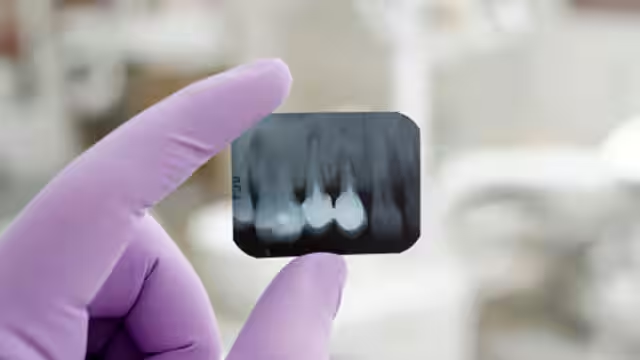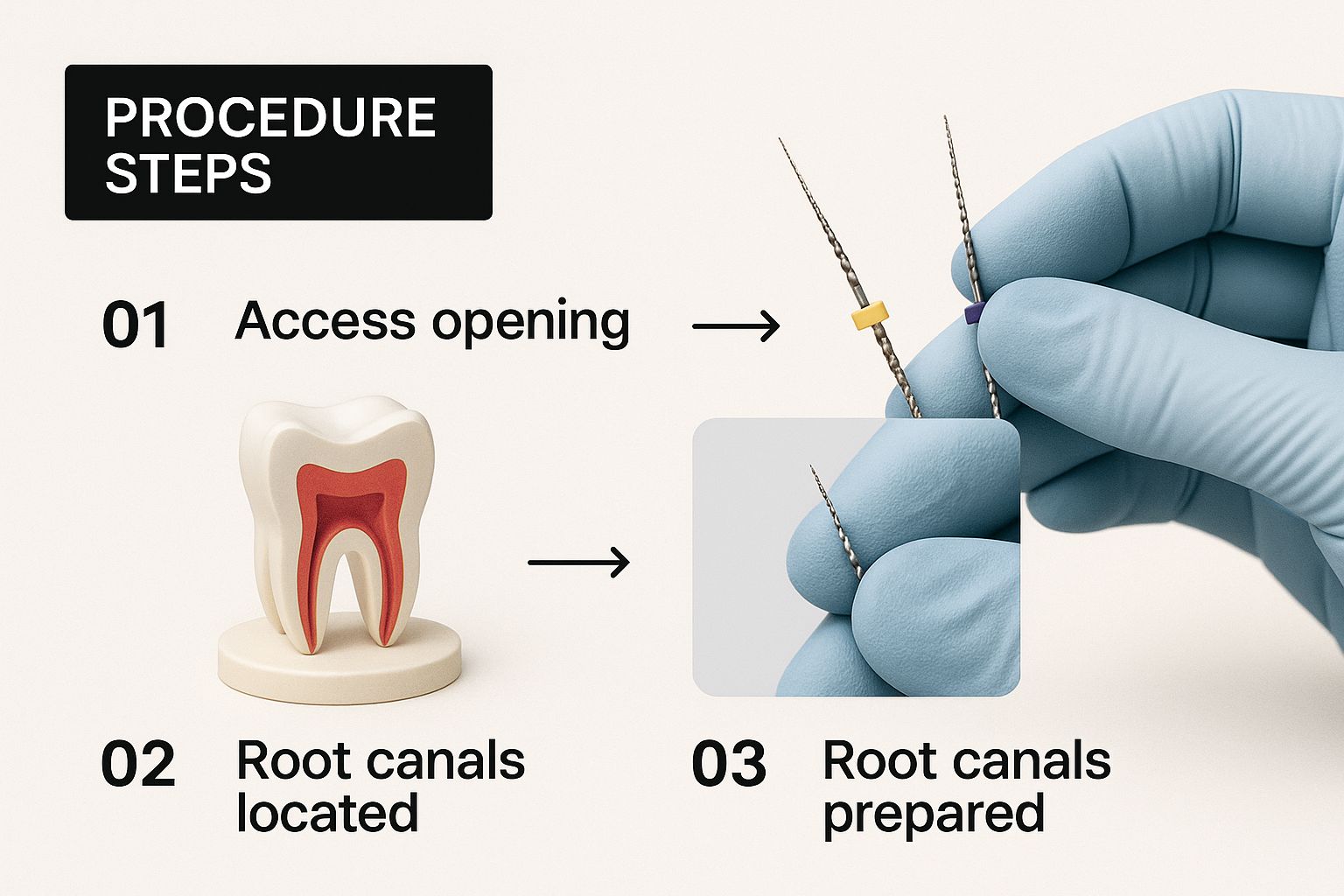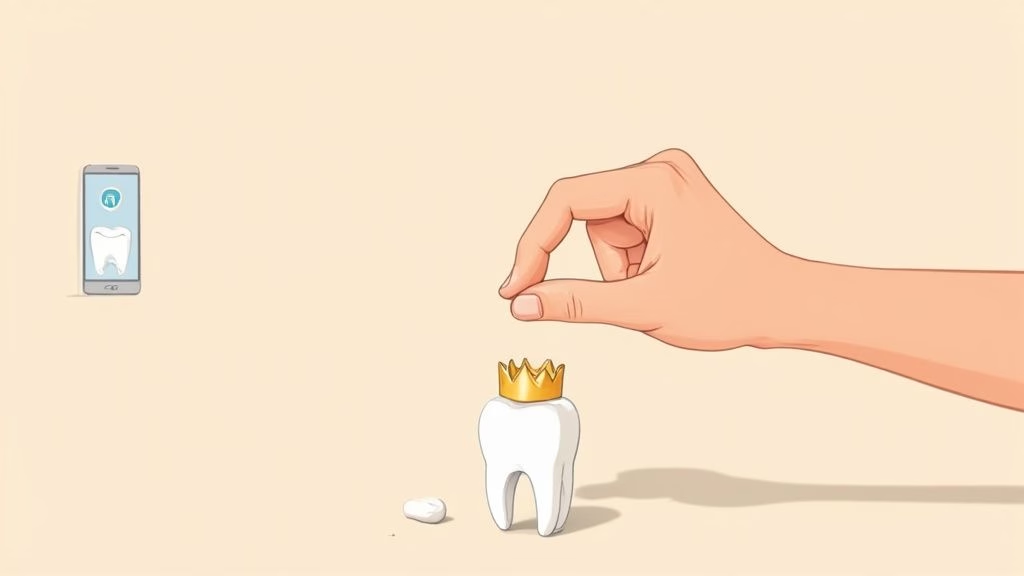What Is Root Canal Treatment and Why Do I Need One?

You’ve probably heard the term “root canal” and maybe even winced a little. It’s a procedure that has a bit of an unfair reputation, mostly thanks to outdated stories. Let’s set the record straight: a root canal isn’t the cause of tooth pain; it’s the cure.
What is a Root Canal, Really?
Think of it this way: a root canal isn’t about pulling a tooth, it’s about saving it. It’s essentially a deep-clean for the very centre of a tooth that has become badly infected, designed to get you out of pain and keep your natural tooth right where it belongs.
Imagine your tooth is like a tiny, hard-shelled nut. On the outside, you have the tough enamel. But on the inside, there’s a soft core called the pulp. This pulp is a network of nerves and blood vessels that helped the tooth grow. When deep decay, a crack, or an injury lets bacteria into this soft centre, the pulp gets infected and inflamed, and that’s when the trouble—and the pain—starts.
What’s the Point of the Treatment?
Once the pulp is infected, it can’t heal itself. The body’s natural response is inflammation and pain, a signal that something is seriously wrong. The goal of a root canal is to solve this problem from the inside out.
The whole process is focused on three key things:
- Getting Rid of the Infection: The dentist carefully removes the inflamed or infected pulp, nerves, and bacteria from inside the tooth’s root system.
- Preventing it from Coming Back: The now-empty chamber is thoroughly disinfected and sealed off to make sure no new bacteria can get back in.
- Saving Your Tooth: By preserving the tooth’s main structure, it can be restored with a crown or filling. This means it can function just like any other tooth for many years to come.
This might sound like a major procedure, but it’s far more routine than you might think. In the UK, the average full-time dentist handles around 70 of these cases every year. It’s a standard, reliable part of modern dentistry. You can read more about these findings from a study on non-surgical root canal treatments in general practice.
For a quick overview, here’s a simple breakdown of what the treatment involves.
Root Canal Treatment At a Glance
| Aspect | Brief Explanation |
|---|---|
| Procedure Name | Root Canal Treatment (or Endodontic Therapy) |
| Main Goal | To save a natural tooth by removing infected pulp. |
| Key Indication | A deep infection inside the tooth causing severe pain. |
| The Process | Clean out the infected pulp, disinfect the canals, and seal the tooth. |
| Pain Level | The procedure itself is done under local anaesthetic and is painless. |
| Recovery | Mild soreness for a few days is normal; most people return to daily life quickly. |
| Final Step | A permanent filling or, more commonly, a crown is placed to protect the tooth. |
This table shows that the treatment is a clear, step-by-step process aimed at restoration.
By cleaning out the infection at its source, a root canal stops the pain in its tracks, prevents it from spreading into your jaw, and saves you from needing an extraction. It’s a procedure that restores health, not one that removes a tooth.
Ultimately, opting for a root canal is a choice to keep your own smile. It helps maintain the natural alignment of your teeth and avoids the cascade of issues that can happen when a tooth is lost.
How to Know If You Might Need a Root Canal
How can you tell if that nagging toothache is just a fleeting issue or something more serious? Your body is usually pretty good at sending out warning signals when a tooth’s inner pulp is in trouble. Knowing what to look for is the first step in stopping a small problem from turning into a major dental emergency.
Think of your tooth’s enamel as a fortress wall. When bacteria find a way to breach it, they can infect the soft, vulnerable pulp inside. A root canal is the procedure designed to get in there, clear out the infection, and save the tooth.
Catching the signs early means you can get help before the pain becomes unbearable. The key is understanding that not all toothaches are created equal; some point directly to an infected pulp that needs urgent attention.
That Deep, Persistent Toothache
The most classic sign is a severe, throbbing pain that just won’t quit. This isn’t your average sensitivity that fades quickly. We’re talking about a deep, constant ache that can make it hard to eat, sleep, or even think straight.
This happens because the infected pulp inside your tooth becomes inflamed, building up pressure with nowhere to escape. It can feel like a relentless ache or a sharp, shooting pain, especially when you bite down. Ignoring this kind of pain is a big mistake, as it’s a clear sign the infection is active and probably getting worse.
If the pain is bad enough to wake you up at night, that’s a massive red flag. It’s time to see a dentist right away. At Toothfairy, we provide a smarter, more affordable way to handle dental emergencies, connecting you with professional advice when you need it most.
Sensitivity That Sticks Around
Another tell-tale sign is a sharp, lingering pain when you have something hot or cold. A brief twinge of sensitivity is one thing, but if the pain hangs around for more than a few seconds after you’ve had your tea or ice cream, it often points to a problem with the tooth’s nerve.
An infected pulp makes the nerves inside go into overdrive. That jolt of pain that doesn’t fade is a classic symptom of nerve damage that a root canal is designed to fix.
This isn’t just a fleeting “ouch.” Think of it as your tooth’s internal alarm system screaming that the nerve is in trouble. When that pain lingers long after you’ve finished your ice cream, it’s a clear message that the nerve is damaged and needs professional help.
Visible Clues in Your Tooth and Gums
Sometimes the signs are less about what you feel and more about what you can see. An infected tooth might start to look different, and the gums around it can show signs of distress too.
Keep an eye out for these visual cues:
- Tooth Discolouration: The tooth might darken, taking on a greyish or even blackish appearance. This is a sign that the tissue inside has died, which changes the tooth’s colour from the inside out.
- Swollen Gums: You might spot tender, swollen gums right next to the painful tooth. Sometimes, the infection creates a small, pimple-like bump on the gum, which is an abscess.
- A Chipped or Cracked Tooth: A deep crack or a significant chip can act like an open door for bacteria to get straight into the pulp. If you’ve damaged a tooth and it’s now causing pain, it’s very likely the pulp has been compromised.
Recognising these symptoms gives you the power to act fast. If you notice any of these signs, getting a professional opinion is crucial. An early root canal can stop the infection in its tracks, get you out of pain, and—most importantly—save your natural tooth.
The Root Canal Procedure: A Step-by-Step Walkthrough
Hearing you need a root canal can be daunting, but most of that anxiety comes from old myths and not knowing what’s actually involved. The reality is, a modern root canal is a methodical, pain-relieving procedure designed to save your natural tooth. Honestly, it’s often no more eventful than getting a standard filling.
Let’s break down the entire process. Once you understand what to expect at each stage, you’ll see how focused the treatment really is on your comfort and long-term dental health.
Step 1: Diagnosis and Preparation
First things first, your dentist needs to be absolutely certain a root canal is the right move. This isn’t a procedure that’s done on a whim; it all starts with a precise diagnosis.
This usually involves a close look at the tooth and a dental X-ray. The X-ray is crucial—it gives your dentist a clear map of your tooth’s root structure and shows just how far any infection has spread into the surrounding bone. This image is the blueprint for the entire treatment.
Once it’s confirmed, the priority shifts to making you comfortable. Your dentist will use a local anaesthetic to completely numb the tooth and the gum around it. Thanks to how effective modern anaesthetics are, the procedure itself should be painless. You might feel a bit of pressure now and then, but you won’t feel any pain.
This infographic gives a great visual summary of the key stages, from getting you numb right through to placing the final restoration.

As you can see, every step logically follows the last: clean, disinfect, and seal the tooth for a predictable, successful result.
Step 2: Cleaning the Root Canals
With the area totally numb, the next job is to isolate the tooth. Your dentist will place a small sheet of rubber, known as a dental dam, around it. This clever little sheet does two vital things: it keeps the tooth perfectly clean and dry, and it stops you from swallowing any of the cleaning solutions used.
Then, a tiny opening is made in the top of your tooth. Think of it as creating a small doorway to get to the source of the problem—the infected pulp chamber.
Using a set of very fine, specialised tools called endodontic files, your dentist will carefully remove the damaged pulp, nerves, and bacteria from inside the root canals. This is the “cleaning” phase. The canals are gently shaped and repeatedly flushed with an antibacterial solution to make sure every last trace of infection is gone. It’s this meticulous cleaning that prevents the problem from coming back.
The real goal here isn’t just to remove the pulp, but to achieve total disinfection. Every canal is scrupulously cleaned and rinsed, creating a sterile environment inside the tooth that’s ready to be sealed.
Step 3: Filling and Sealing the Tooth
Once the canals are spotlessly clean and dry, they need to be filled to block out bacteria for good. Your dentist will use a rubber-like, biocompatible material called gutta-percha.
This material is gently warmed and packed into each canal to create a complete, watertight seal from the tip of the root right up to the top. This effectively walls the tooth off from the rest of your body, ensuring bacteria can’t get back in. To finish this stage, a temporary filling is placed over the opening.
This temporary filling protects the tooth and keeps it sealed until your next visit for the final restoration.
Step 4: The Final Restoration
The root canal treatment itself is now done, but one crucial step remains for long-term success. A tooth without its pulp can become more brittle over time, making it more likely to fracture when you’re chewing.
To prevent this, a permanent restoration is absolutely essential. For most teeth, this means fitting a dental crown. The crown acts like a protective helmet, restoring the tooth’s strength, shape, and function. This isn’t an optional extra; it’s what ensures your saved tooth will last for years and years.
At Toothfairy, we understand that great cosmetic dental work is about function just as much as appearance. We provide a smarter, more affordable way to connect with dentists who provide top-quality restorations, making sure your treated tooth not only feels strong but also blends seamlessly into your smile.
Why Saving Your Natural Tooth Matters
When you’re dealing with the intense pain of a tooth infection, you might just want the problem gone—and fast. It’s tempting to think that pulling the tooth is the simplest fix, but it’s really important to consider what you’d be losing. Opting for a root canal isn’t just about dealing with the infection; it’s a deliberate choice to save a crucial part of your natural smile.
The most obvious benefit is, of course, keeping your own tooth. Think of your teeth as a tightly-knit team. They support each other and keep everything in line. When one tooth is lost and the gap is left empty, the neighbouring teeth can start to drift, which can throw your bite out of alignment and make chewing a real chore.
The Immediate Relief and Long-Term Stability
Let’s talk about the pain first. That throbbing, can’t-think-straight ache from an infected tooth is caused by pressure building up on the nerve inside. One of the best things about a root canal is the almost instant relief you feel once the source of that infection is removed. It stops the pain right in its tracks.
On top of that, a root canal effectively quarantines the infection. If you don’t treat it, the bacteria can spread down into your jawbone and cause a painful abscess. In very rare cases, it can even get into your bloodstream, leading to much bigger health problems. By cleaning and sealing the tooth, you’re locking the infection out for good.
Keeping your natural tooth also brings some unseen advantages:
- Preserves Your Jawbone: The root of your tooth isn’t just an anchor; it stimulates the jawbone, keeping it dense and strong. When a tooth is removed, the bone in that area begins to recede over time.
- Maintains How You Chew: Nothing chews quite like a natural tooth. Keeping yours ensures your bite stays balanced and you can eat comfortably and efficiently.
- Avoids More Complicated Work Later: Pulling a tooth might seem easier now, but it often opens the door to more complex and expensive treatments down the line, such as a bridge or a dental implant to fill the gap.
Confidence in a Highly Successful Treatment
It makes sense to want a solution you can count on. Modern root canal treatment is exactly that—it’s not a temporary patch-up, but a permanent fix designed to last a lifetime with the right care. The whole process of meticulously cleaning, disinfecting, and sealing the inside of the tooth has been fine-tuned over many years to be incredibly reliable.
In fact, the success rate for root canals here in the UK is remarkably high, typically sitting between 85% and 97% according to recent studies. Success is usually measured by the pain and infection being completely gone and the bone around the tooth healing properly. You can read more about the positive prognosis of root canal treatments from these findings. This track record makes it one of the most dependable procedures in all of dentistry.
Opting for a root canal is an investment in your long-term oral health. It’s a choice to maintain your smile’s natural structure, function, and appearance, preventing a cascade of future dental problems.
Protecting Your Smile for the Future
Saving your tooth does more than just fill a space; it protects the integrity of your entire smile. It means you can keep eating the foods you enjoy without a second thought and feel confident when you speak and smile. At Toothfairy, we believe in treatments that put your natural teeth first, offering smarter, more affordable ways to handle dental emergencies and cosmetic dental work. A root canal fits that philosophy perfectly.
Think of it this way: replacing a lost tooth is like finding a spare part for a complex machine. While modern replacements like bridges and implants are fantastic, nothing ever functions quite as perfectly as the original. A root canal lets you keep that original part, restoring it to full working order so you can get on with your life, pain-free.
Your Recovery and Aftercare Guide
A successful root canal doesn’t end when you leave the dentist’s chair. In fact, what you do in the hours and days that follow is just as vital as the treatment itself. Getting the aftercare right is your ticket to a smooth, comfortable recovery and a healthy tooth for the long haul.
It’s perfectly normal to feel some tenderness or sensitivity around the treated tooth for a few days. Your body has just done some serious healing work, and the surrounding tissues need a little time to settle down. This discomfort should be mild and get noticeably better each day.
For most people, any soreness is easily managed with standard over-the-counter pain relievers like ibuprofen or paracetamol. It’s often compared to the feeling after a deep filling—a temporary ache that tells you the healing process is well underway.
What to Do Immediately After Your Procedure
For the first few hours, the local anaesthetic will still be doing its job. The numbness is great for comfort, but it also means you won’t feel your cheek or tongue properly. It’s a good idea to hold off on eating until the feeling has completely returned to avoid any accidental bites.
When you do feel ready for a meal, go for soft foods for the first day or two. This simple step takes the pressure off your treated tooth, giving it the peaceful environment it needs to recover.
Here are a few quick tips for the first 24-48 hours:
- Choose soft foods: Think soups, yoghurts, mashed potatoes, or smoothies.
- Chew on the other side: Give the treated tooth a complete rest by using the opposite side of your mouth.
- Be gentle when cleaning: Keep brushing and flossing, but just use a lighter touch around the sensitive area.
The single most important rule of aftercare? Protect the tooth until it has its final, permanent restoration. Your tooth is at its most vulnerable right now, so these simple precautions are absolutely crucial.
The Final, Essential Step: The Permanent Restoration
Think of your root canal treatment as a two-part process. The procedure itself is part one, but it isn’t truly finished until the tooth is properly sealed and protected with a permanent restoration. The temporary filling is only a placeholder; it’s not built to handle the serious business of chewing.
A tooth that has had its pulp removed can become more brittle over time. That’s why placing a dental crown is the final, non-negotiable step. The crown acts like a custom-fitted helmet, restoring the tooth’s strength and shielding it from the risk of fracture. Skipping this step is one of the most common reasons a root-canal-treated tooth fails down the line. It’s what ensures the long-term success of the entire treatment.
At Toothfairy, we know that great cosmetic dental work is where strength meets aesthetics. We offer a smarter, more affordable way to access dentists who will craft a final crown that not only protects your tooth but also blends seamlessly with your smile. Completing this final step is the best way to guarantee your tooth stays healthy and functional for many years to come.
Costs and Alternatives to Root Canal Treatment
Let’s talk frankly about the investment involved in looking after your dental health. Getting your head around the costs and what your options are is vital for making a decision you feel good about, especially when you’re dealing with pain. The price of a root canal isn’t just a number; it’s a reflection of a highly skilled procedure designed to save your natural tooth for years to come.
In the UK, the cost for a private root canal can vary quite a bit. The final figure really depends on a couple of key things: which tooth needs the work (molars at the back have more canals and are trickier than the front teeth), and just how complicated the root structure is. While the initial investment might seem steep, it’s worth thinking about it in terms of what you’re actually saving.
At Toothfairy, we’re passionate about making essential dental care accessible. We help patients find smarter, more affordable ways to manage everything from dental emergencies to cosmetic dental work, so you can get the expert treatment you need without the financial headache.
The Main Alternative: Tooth Extraction
When a tooth is badly infected, the main alternative to a root canal is simply having it taken out. On the surface, an extraction often looks like the easier and cheaper choice. The upfront cost is definitely lower, and the procedure itself is quicker.
However, this is a classic example of a short-term saving that can lead to long-term costs. Taking a tooth out creates an immediate gap, which can set off a chain reaction of other dental problems down the road. It’s really important to understand what those knock-on effects are before you decide.
Choosing extraction over a root canal can seem like an easy fix for immediate pain and cost concerns. However, it’s vital to weigh the lower initial price against the potential for much higher future expenses and more complex dental work needed to address the consequences of a missing tooth.
Long-Term Consequences of Extraction
Losing a permanent tooth is about much more than just how your smile looks. That empty space can cause some significant problems for your overall oral health.
- Shifting Teeth: The teeth on either side of the gap will naturally start to tilt and drift into the empty space. This messes up your bite and alignment, potentially leading to problems that need orthodontic work to fix—a far bigger deal than a single root canal.
- Bone Loss: Your tooth roots play a crucial role in stimulating your jawbone, keeping it strong and dense. When a tooth is pulled, that stimulation disappears, and the bone in that area begins to shrink and recede.
- Future Costs: To prevent these issues, a gap usually needs to be filled. Solutions like a dental bridge or implant are fantastic, but they are significantly more expensive than the original root canal would have been.
Thinking through these points can feel overwhelming, so I’ve put together a table to lay it all out clearly. It should help you see the full picture when comparing the two options.
Comparing Root Canal Treatment vs Tooth Extraction
| Consideration | Root Canal Treatment | Tooth Extraction |
|---|---|---|
| Upfront Cost | Higher initial investment. | Lower initial investment. |
| Main Goal | Saves your natural tooth and root. | Completely removes the tooth and root. |
| Jawbone Health | Preserves the jawbone by keeping the natural root. | Leads to gradual bone loss in the extraction site. |
| Bite Alignment | Maintains the natural position of all teeth. | Can cause adjacent teeth to shift and misalign. |
| Long-Term Cost | The tooth is saved; future costs are usually limited to crown maintenance. | Often requires a more expensive bridge or implant later. |
| Function | Restores full chewing function to your natural tooth. | Creates a gap, which can make chewing difficult. |
Ultimately, the goal of a root canal is to preserve what you have. While an extraction deals with the immediate problem, it often creates new ones for the future. Saving your natural tooth is almost always the best approach for your long-term health and your wallet.
Answering Your Root Canal Questions
Even with a good understanding of the procedure, it’s completely normal to have a few more questions rattling around. To help put your mind at ease, we’ve tackled some of the most common queries we hear from patients.
Is a Root Canal Painful?
This is probably the most persistent myth in all of dentistry, and the answer is a firm no. With modern local anaesthetics and advanced techniques, the actual procedure shouldn’t feel any more intense than a routine filling.
The whole point of a root canal is to get you out of the severe pain caused by the infection, not create more. Most people are pleasantly surprised at how comfortable the process is and feel nothing but relief once it’s over.
How Many Appointments Will It Take?
This really comes down to the tooth itself. A simple root canal on a front tooth, which typically has just one root canal, can often be done and dusted in a single visit of about 90 minutes.
On the other hand, a molar at the back of your mouth is a more complex beast. It can have multiple canals that are curved or tricky to access, so your dentist might schedule two appointments. This gives them the time needed to be thorough and make sure every nook and cranny is perfectly cleaned, disinfected, and sealed. Your dentist will always give you a personalised timeline.
Will I Definitely Need a Crown Afterwards?
For the vast majority of cases, yes. Think of it as an essential final step for the long-term health of the tooth. Once the living pulp is removed, the tooth can become more brittle and is at a higher risk of fracturing under the pressure of everyday chewing.
A dental crown isn’t just for looks; it’s like a custom-fitted helmet for your treated tooth. It restores its strength, protects it from biting forces, and lets you chew with confidence for years. Getting a crown is a vital investment in protecting your tooth.
What Happens If I Put Off My Root Canal?
Delaying a root canal is one of the worst things you can do for your tooth. Putting it off gives the bacteria inside a golden opportunity to multiply, making the infection—and the pain—much worse.
That infection can eventually spread beyond the tooth’s root and into your jawbone, leading to a painful abscess. If left for too long, the damage can become so severe that the tooth can’t be saved at all, making extraction the only option left. The sooner you act, the better your chances of stopping the pain and keeping your natural tooth.
At Toothfairy, we believe accessing expert dental care should be simple and affordable. Whether you’re facing a dental emergency, considering cosmetic dental work, or looking for a smarter way to straighten your teeth, we connect you with qualified UK dentists who can provide the care you need, when you need it. Find out how we can help you at https://www.toothfairyapp.co.uk.
Last updated on August 22, 2025

Toothfairy Care Team
Toothfairy, is the world's smartest dental app, that connects patients to a dentist for a range of issues, from emergencies, cosmetics, prescriptions to virtual exams.
Toothfairy Care Team
Toothfairy, is the world's smartest dental app, that connects patients to a dentist for a range of issues, from emergencies, cosmetics, prescriptions to virtual exams.





